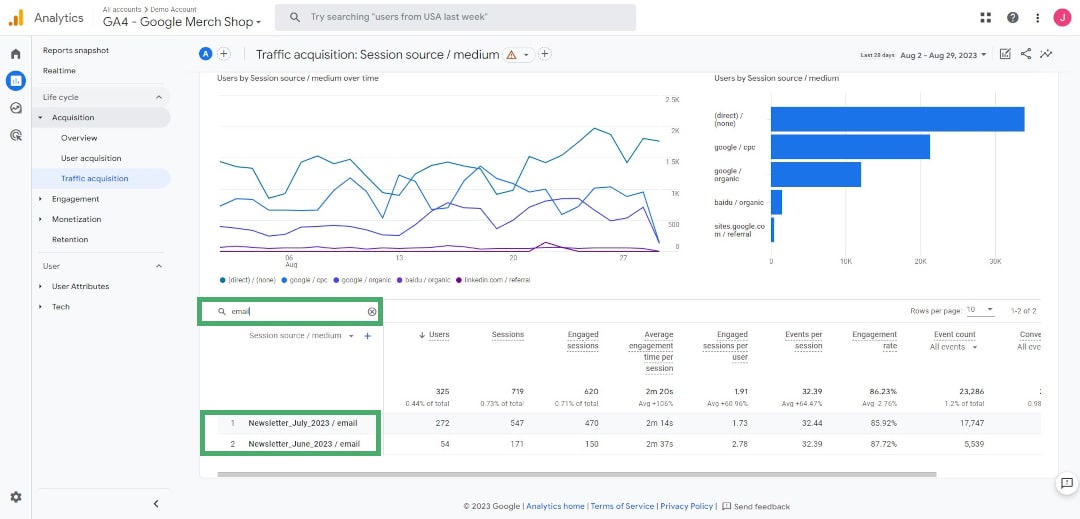Help Centre
Support > Website Performance > Google Analytics 4
A Beginner's Guide to UTM Links: An Overview & Tips for Success
What are UTM Links?
UTM links are customised URLs that include extra pieces of information. These pieces of information allow you to track and analyse the performance of your marketing more precisely.
You will have likely seen UTM links before. They often appear like this after clicking a link from another platform:
www.example.com/blog?utm_source=newsletter&utm_medium=email&utm_campaign=name
UTMs are particularly useful for understanding how users interact with a link that’s shared across different platforms and campaigns.
These links can be really easily set up so that you can reliably obtain useful data that helps you make future marketing and business decisions.
We’ll show you how in this guide, as well as provide tips and inspiration to help you get the most out of your UTM Links.
The Components of a UTM Link
A UTM link contains several parameters that you can customise:
-
URL: Your regular link to the webpage you're directing users to.
-
Source: The platform or website where the link is shared, like "Facebook" or "Twitter."
-
Medium: The type of medium, such as "email" or "banner ad."
-
Campaign: The name of the campaign you're running, like "SummerSale2023."
-
Term (optional): Used for tracking keywords in paid search campaigns.
-
Content (optional): Differentiates between versions of the same link, such as different ad designs.
How To Set Up UTM Links
-
Choose a UTM Link Generator: There are online tools like Google's Campaign URL Builder that make generating UTM links easy.
-
Enter your URL: Paste the link to the page or content you want to track.
-
Fill in your Parameters: Enter your details for source, medium, campaign name. The other fields are optional if required.
-
Generate a UTM Link: The tool will generate a unique UTM link for you to use. Where you would have shared your regular link before, you now use this link where you have specified the parameters.
Why Use UTM Links?
UTM links provide valuable insights into your marketing efforts by helping you answer questions like:
-
Which sources drive the most traffic to your website?
-
Which marketing campaigns generate the most clicks?
-
How effective are your social media posts at driving conversions?
For example, you could use UTM links when you want to track:
-
Different Marketing Channels: If you share links across various platforms like social media, email, and ads, UTM links help you identify which channels are most effective. UTM links help keep data separate so you can analyse each part of your marketing.
-
Multiple Campaigns: For each marketing campaign you run, UTM links help you differentiate their impact on traffic and engagement. They make finding and analysing performance for each campaign much easier.
-
Specific Content: If you're promoting various types of content within a single campaign, UTM links can tell you which content drives the most engagement. You can pinpoint exactly what messaging resonates and double down your efforts there for more success.
Examples
Here are a couple of real-life scenarios where using UTM links would be beneficial:
Scenario 1: Multi-Platform Social Media Campaign
Imagine you're running a social media campaign for a new product launch. You're promoting it on Facebook, Twitter, and Instagram. By using UTM links, you can track which platform is driving the most traffic and conversions to your product page.
UTM Parameters:
-
Source: Facebook, Twitter, Instagram
-
Medium: Social Media
-
Campaign: ProductLaunch2023
With UTM links, you can determine which platform is the most effective at reaching your target audience, allowing you to allocate your resources more efficiently for future campaigns.
Scenario 2: Email Newsletter Engagement
You're sending out an email newsletter to your subscribers with links to different blog articles and a special offer. By using UTM links in the email, you can measure which articles are getting the most clicks and which links are leading to the most conversions on your website.
UTM Parameters:
-
Source: Newsletter
-
Medium: Email
-
Campaign: AugustNewsletter
This data will help you understand your audience's interests better and tailor your content to match their preferences. Additionally, you can assess the effectiveness of your call-to-action in the email and refine your strategies for future newsletters.
Using UTM links in these scenarios enables you to gain insights that can shape your marketing decisions, optimise your campaigns, and improve overall engagement and conversions.
How To Analyse UTM Links
To analyse the performance of any of your campaigns using UTMs, you’ll need to head to Google Analytics 4.
You can search for any of your UTM parameters (campaign, medium, source) by what you named them. This will bring up the data that the UTM has collected.
One of the best places to analyse your UTMs, however, is in the Traffic Acquisition Report.

As you can see in the example above, using UTM links across two newsletter emails, we are now able to compare the performance of each and determine what factors lead to success.
-
Head to Reports >> Life Cycle >> Acquisition >> Traffic Acquisition
-
Enter your search criteria in the bottom-left of the graph. In the screenshot above, we searched for our Medium parameter: Email
-
Switch the Session default channel group dropdown to Session source / medium to get a wider overview across campaigns and traffic sources
Best Practices for Using UTM Links:
-
Be Consistent: Maintain consistent naming conventions for UTM parameters across your campaigns. Capitalisation will affect your reporting, for example, so outline from the start how you will lay out your UTMs
-
Avoid Overloading: Don't use too many UTM parameters as it can become confusing to manage. It’s best just to have a few at any one time so you don’t have too many data points you have to refer to.
-
Use URL Shorteners Carefully: If you use URL shorteners, ensure they retain your UTM parameters. You can click your shortened link and look at your url in your browser to see if your parameters have been added.
-
Track Your UTMs in a Spreadsheet: It can be challenging to try to remember all of the parameters you have set up. Make sure you keep a record of what you’re using and where for future reference.
-
Regularly Review Data: It’s good practice to check in over a regular time frame you decide. At this point, you can make strategic decisions for your marketing campaign and decide what actions you need to take moving forwards to maximise your results.
Related Articles
Related Articles
More Questions?
If you have any further questions, please get in touch and we will be happy to help.
Get in Touch


